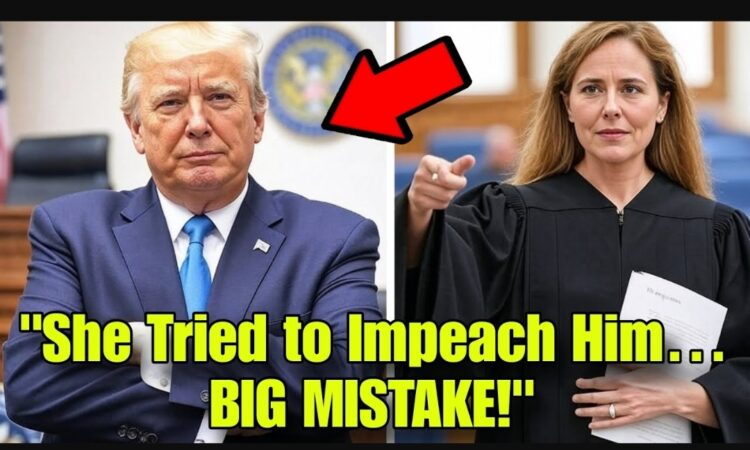Judge Amy Coney Barrett Tries to IMPEACH Donald Trump, Moments Later The Unexpected Took Place

The morning air was thick with tension as whispers spread through the corridors of power. Justice Amy Coney Barrett had arrived at the Supreme Court before dawn, her face set in grim determination as she carried a sealed envelope containing what she believed would be the end of Donald Trump’s presidency.
The documents inside outlined what she claimed were impeachable offenses – abuse of power, obstruction of justice, violations of the constitution. As she handed them to the clerk of the court, her hands trembled slightly, not from doubt but from the weight of the moment. The clerk’s eyes widened as he read the first page, immediately summoning the Chief Justice for an emergency session.
Across town, President Trump was finishing his morning briefing when an aide rushed in, face pale. “Mr. President, Justice Barrett is filing impeachment charges.” Trump’s expression didn’t change. He slowly set down his coffee, stood, and walked to the window overlooking the White House lawn. After a long silence, he turned and said simply, “Get me the files from the safe. It’s time.
His personal attorney arrived within minutes carrying a worn leather briefcase containing documents that had been compiled over months – bank records, flight manifests, encrypted text messages that painted a very different picture of Justice Barrett.
The Supreme Court chamber was packed beyond capacity when Trump arrived. Reporters jostled for position, senators whispered urgently in the gallery, and the other justices sat stone-faced as Barrett presented her case. Her voice rang clear as she detailed the articles of impeachment, each accusation met with gasps from the audience. When she finished, there was a heavy silence.
Then Trump’s attorney stood. “Your Honors, before proceeding, we must bring to light new evidence that fundamentally changes these proceedings.” He approached the bench with three thick binders, placing them before the Chief Justice. “What you hold here proves that Justice Barrett has been compromised.”
The room erupted. The Chief Justice banged his gavel furiously as Barrett leapt to her feet. “This is outrageous!” she shouted, but the damage was done. As the justices examined the documents, their expressions turned from skepticism to shock.
The evidence was meticulous – records showing Barrett had secretly met with opposition leaders at a private estate in the Hamptons, bank transfers from political action committees to shell companies linked to her brother, even transcripts of phone calls where she discussed “taking down” the administration. Most damning was a series of emails between Barrett and a foreign diplomat discussing how impeachment could weaken America’s position in ongoing trade negotiations.
Barrett’s face went ashen as the Chief Justice ordered a recess. In his chambers, the justices reviewed the materials in stunned silence. Meanwhile, outside the courthouse, news of the scandal spread like wildfire. Protesters on both sides flooded the streets, their chants audible inside the marble halls.
Trump remained calm through it all, sitting quietly at the defense table, occasionally whispering to his legal team but otherwise showing no reaction. When the court reconvened, the Chief Justice’s voice was heavy with regret as he announced Barrett’s immediate suspension pending a full investigation.
In the days that followed, more revelations emerged. Investigators discovered Barrett had been leaking confidential court deliberations to political operatives. Her financial records showed unexplained deposits totaling millions. Perhaps most shockingly, phone records placed her at a secret meeting with foreign agents just days before filing the impeachment charges.
The media frenzy was unprecedented – 24-hour news cycles dissecting every detail, legal analysts debating the constitutional implications, late-night hosts cracking jokes that rang hollow in the face of such a profound betrayal of public trust.
Trump addressed the nation from the Oval Office, his tone solemn rather than triumphant. “This was never about me,” he said. “It was about preserving the integrity of our institutions.” Behind the scenes, he ordered the Justice Department to handle the investigation with strict neutrality, recusing himself from all decisions to avoid any appearance of retaliation.
Meanwhile, Barrett retreated from public view, her once-promising career in ruins. Her former colleagues on the bench distanced themselves, and law schools revoked speaking invitations. The impeachment documents she had filed with such confidence were quietly archived, a footnote in history.
The fallout reshaped Washington. Congress passed sweeping judicial reform measures. The Supreme Court adopted new transparency protocols.
And in quiet moments, those who had witnessed the events firsthand – the clerks, the reporters, the staffers – would reflect on how close the nation had come to a constitutional crisis, and how one man’s preparedness had averted disaster.
Trump’s approval ratings soared, not because of partisan victory, but because the American people saw in that crisis a leader who put the country first. The story would be told for generations – not as a political drama, but as a cautionary tale about power, justice, and the fragile balance between them.




